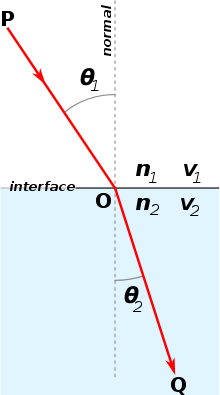Optics (Ptolemy)

Textual history
The work is known to have been received by Arabic scholars working on optics in the 10th and 11th century, specifically
Eugene's text was influential in the late medieval and
Contents

The work contains the earliest surviving table of refraction from air to water, for which the values (with the exception of the 60° angle of incidence), although historically praised as experimentally derived, appear to have been obtained from an arithmetic progression.[5]
However, according to Mark Smith, Ptolemy's tables were based on real experiments. His "adjustment" of the data, using arithmetic progression, is essentially the method of regularizing irregularly-changing values, which was often used by astronomers. This was done in order to organize and make sense of the tables' data in a rational way.[6]
Ptolemy also presents a theory of vision. In his view, rays (or flux) are emitted from the eye. The rays are sensitive, and convey information back to the observer's intellect about the distance and orientation of surfaces. Size and shape were determined by the visual angle subtended at the eye combined with perceived distance and orientation. This was one of the early statements of size-distance invariance as a cause of perceptual size and shape constancy, a view supported by the Stoics.[7]
Ptolemy offered explanations for many phenomena concerning illumination and colour, size, shape, movement and binocular vision. He also divided illusions into those caused by physical or optical factors and those caused by judgmental factors. He offered an obscure explanation of the sun or moon illusion (the enlarged apparent size on the horizon) based on the difficulty of looking upwards.[8][9]
See also
References
- ^ Smith 1996, p. 3.
- ^ Smith 1996, p. 5.
- ^ Smith (1996), p. 3, referencing Lejeune (1956), p. 27.
- ^ Lindberg 1975.
- ^ Boyer 1959.
- ^ Smith 2015, pp. 116–118.
- ^ Ross & Plug 1998.
- ^ Ross & Ross 1976, p. 377.
- ^ Sabra 1987.
Bibliography
- Boyer, Carl Benjamin (1959). The Rainbow: From Myth to Mathematics. New York: Thomas Yoseloff.
- Lejeune, Albert (1989) [first published in Louvrain, 1956]. L'Optique de Claude Ptolémée dans la version latine d'après l'arabe de l'émir Eugène de Sicile. Brill.
- Lindberg, David C. (1975). A Catalogue of Medieval and Renaissance Optical Manuscripts. Toronto.
{{cite book}}: CS1 maint: location missing publisher (link) - Ross, H.E.; Ross, G.M. (1976). "Did Ptolemy Understand the Moon Illusion?". Perception. 5 (4): 377–395. S2CID 23948158.
- Sabra, A.I. (1987). "Psychology Versus Mathematics: Ptolemy and Alhazen on the Moon Illusion". In Grant, E.; Murdoch, J.E. (eds.). Mathematics and Its Application to Science and Natural Philosophy in the Middle Ages. Cambridge: Cambridge University Press. pp. 217–247.
- Ross, H.W.; Plug, C. (1998). "The History of Size Constancy and Size Illusions". In Walsh, V.; Kulikowski, J. (eds.). Perceptual Constancy: Why Things Look as They Do. Cambridge: Cambridge University Press. pp. 499–528.
- Smith, A. Mark (2015). From Sight to Light: The Passage from Ancient to Modern Optics. Chicago: The University of Chicago Press.
- Smith, A. Mark (1996). Ptolemy's Theory of Visual Perception– An English translation of the Optics. The American Philosophical Society. ISBN 0-87169-862-5.
